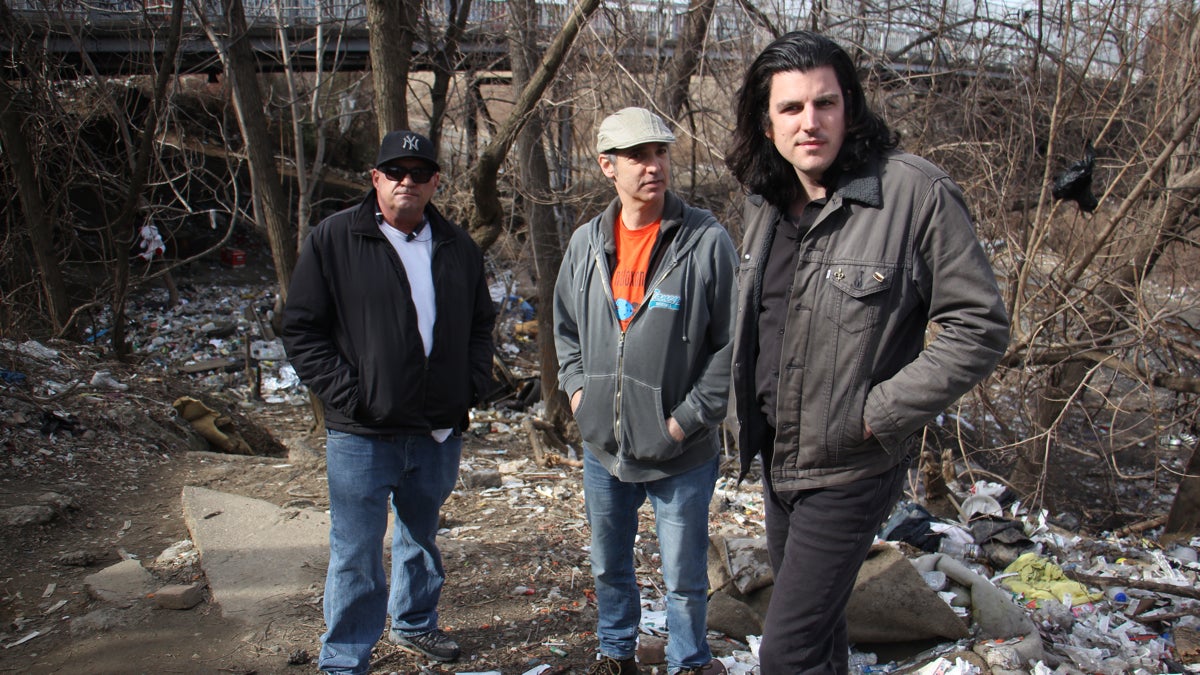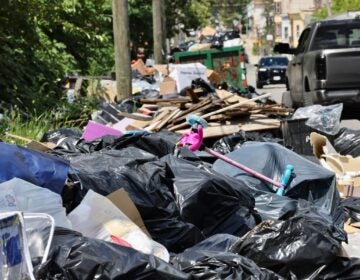Group urges Philadelphia to consider ‘supervised injection site’ to curb fatal ODs

At a heroin camp in Kensington, activists (from left) Paul Yabor, Paul Cherashore and Dan Martino make the case for safe injection sites in the city. (Emma Lee/WHYY)
Seattle last month became the first U.S. city to approve “supervised injection sites” as part of an effort to deal with the nationwide opioid crisis. A small group of community activists is hoping Philadelphia — with more than 900 overdose deaths in 2016 — will be next.
Dan Martino, Paul Cherashore and Paul Yabor made their case Tuesday at “El Campamento,” the squalid stretch along the railroad tracks in Kensington that has long been ground zero in Philadelphia’s opioid epidemic — and has become the focus of the city’s new efforts to fight it.
Makeshift huts offer flimsy shelter for the addicts who gather here. The ground is littered with trash, a tableau of broken furniture, soda bottles, filthy clothes and, of course, used syringes with bright orange caps.
Martino, Cherashore and Yabor are all members of the Philadelphia Opioid Prevention Initiative or POPI. Their mission is to convince city leaders to replace “El Campamento” with a supervised injection site.
Popular in Europe, these sites offer drug users clean syringes, opioid “antidotes” such as naloxone and access to treatment programs. Medically trained observers step in if something goes wrong. In January, Seattle officials approved two such sites.
POPI is working on a grassroots campaign to urge Philadelphia’s new opioid task force to consider the idea. Martino, who said he gathered about 30 signatures from supporters at a recent listening session held by the task force, plans to launch an online petition this week.
For all three men, the cause is personal: Martino’s sister’s boyfriend died from an overdose a few years ago and his brother and cousin have struggled with addiction, while Yabor and Cherashore are both in recovery.
Cherashore claims his life was saved at an “underground” safe injection site where observers gave him naloxone to reverse an overdose and stayed by his side for several hours afterwards.
Martino, who is also secretary of the Olde Richmond Civic Association, knows the idea of giving addicts a sanctioned place to shoot up won’t be popular in the neighborhood or among those who believe it’s simply condoning illegal drug use.
“People who are concerned about this being in their backyard, we totally understand,” he said. “That’s why we need a safe injection site, so that people who are addicted have a place to go so they can be clean, they can get safe needles.”
“We do street cleanups in our own civic association and, over the past two weeks, we’ve found over 12 needles in public parks and public spaces, in the street,” Martino added. “This is a way to get those needles out of the street and get the addicts help.”
City health officials declined to comment on the concept or whether they plan to recommend it, but confirmed that safe injection sites are part of a raft of community suggestions the task force is considering as it prepares its final report to Mayor Jim Kenney.
Yabor is hopeful. He pointed out that, at one time, the concept of creating a needle exchange in Philadelphia was controversial. Now, he volunteers at Prevention Point, a major needle exchange program that has distributed millions of clean syringes.
“Over 10 years ago, there was no naloxone on the street, and it took some grass-roots initiative and people to speak out to get that changed,” Yabor said. “I see this as a natural progress of those kinds of initiatives.”
WHYY is your source for fact-based, in-depth journalism and information. As a nonprofit organization, we rely on financial support from readers like you. Please give today.




